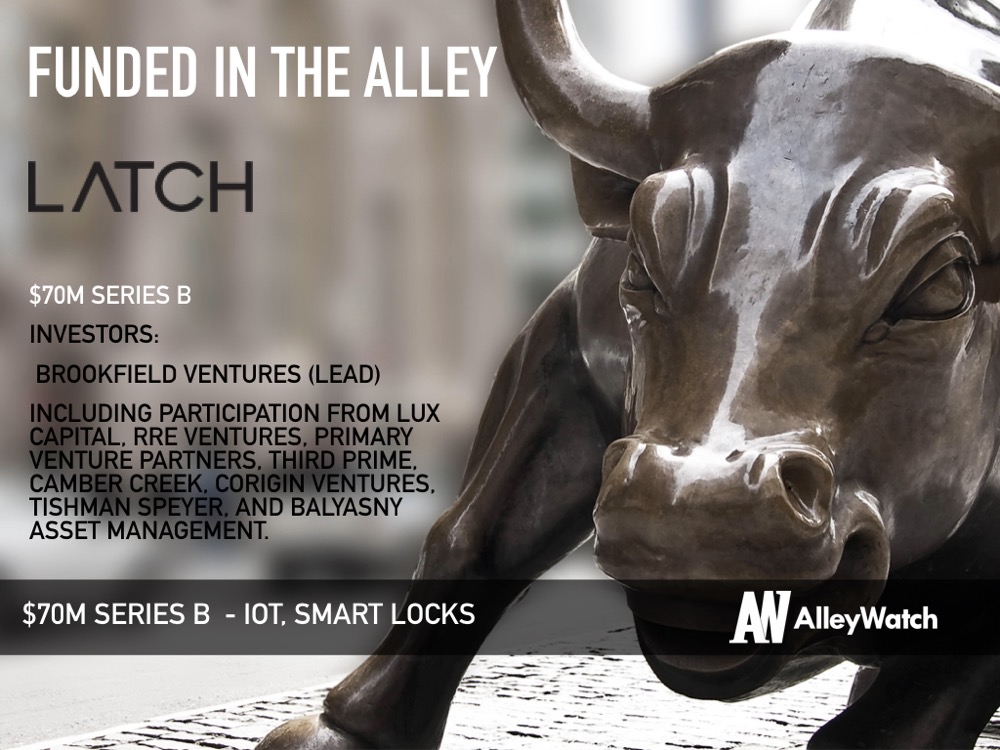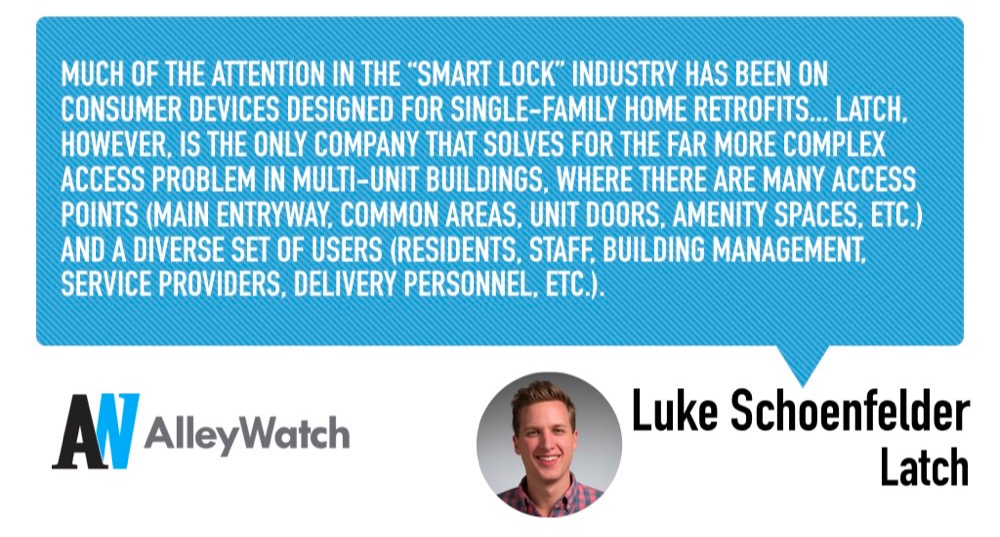While the lock of the future is now available at your fingertips, the platform behind it is more complex than a simple tap. Latch is the first and only smart access system designed for multi-unit buildings, and it’s powered by industry-leading security and encryption technology. Latch’s IoT-powered system allows residents and building operators to unlock doors throughout a building – main entrances, individual apartments, health centers, and other amenity spaces – all through a smartphone. Cofounded by a former Apple employee, Latch blends a modern design with an easy-to-use elegant platform. Getting locked out is now a distant memory and access is now optimized, fueled by Latch.
AlleyWatch spoke with CEO and cofounder Luke Schoenfelder to discuss Latch’s exciting trajectory, future plans, trailblazing technology, and the company’s latest impressive funding round, which brings its total funding to $96M over four rounds.
Who were your investors and how much did you raise?
We raised $70M in our Series B financing round led by Brookfield Ventures and Lux Capital, RRE Ventures, Primary Venture Partners, Third Prime, Camber Creek, Corigin Ventures, Tishman Speyer, and Balyasny Asset Management also joined the round.
Tell us about the product or service that Latch offers.
Latch is the first and only smart access system for multifamily buildings. With Latch, residents and building operators can use a smartphone, keycard, or doorcode to unlock doors through a building, including at their main entrance, their apartment unit, gym, and other amenity spaces and can also automate access for things like UPS deliveries.
 What inspired you to start Latch?
What inspired you to start Latch?
I’ve been interested in infrastructure since I was a kid. While in college, Latch’s cofounder and CTO, Brian Jones, and I went to Haiti after the earthquake and started a small company that was building smart meter devices that would help Haitians pay their energy bills via SMS, something they had never been able to do. It was during that experience that I started to really think deeply about how innovative technology can solve systemic, infrastructure-related problems using business to business sales to drive a new consumer experience. Fast forward to 2013, when I realized that the way we access large buildings was ripe for that kind of innovation, especially with the trend towards on-demand services and e-commerce. The whole picture hit me pretty quickly, and I cashed out my small 401k from my time at Apple, filed for a patent for the world’s first smart access system, and began development.
How is Latch different?
Latch is the first smart access system that provides a full-building solution and a suite of mobile and web-based software tools that work together to support the needs of residents, building owners, and trusted service providers.
Much of the attention in the “smart lock” industry has been on consumer devices designed for single-family home retrofits. The access problems that these devices solve for are relatively minor, usually a single point of entry and a limited number of users. Latch, however, is the only company that solves for the far more complex access problem in multi-unit buildings, where there are many access points (main entryway, common areas, unit doors, amenity spaces, etc.) and a diverse set of users (residents, staff, building management, service providers, delivery personnel, etc.).
Latch is also the first system to offer integrated smart access deliveries directly with national package carriers. For residents living in buildings that are Latch-enabled, carriers are pre-credentialed to leave packages inside the building lobby or another secure space.
As smart access grows in popularity and use cases, security becomes a pressing issue. How do you think about securing Latch from potential hackers or attacks now and in the future?
Each Latch device is built on industry-leading security, uses encryption technologies and undergoes rigorous third-party audits and inspections.
Any unlock attempt is recorded in a digital audit trail, which also includes a photo taken by the device when a public door is accessed or guest use is granted. At Latch, security is one of our top priorities, and we continue to evolve products to ensure that Latch is safe and secure for our customers.
What market does Latch target and how big is it?
Latch currently only sells to multifamily property developers, owners, and operators. There are currently about 20M multi-family residential units in the United States, with about 350K added each year via new construction. This translates to over 64M Americans living in multi-family residential buildings, roughly 22% of the total population living in permanent structures.
What’s your business model?
We sell smart access devices and management software to multifamily developers, managers, and owners.
What was the funding process like?
We’ve always been fortunate to work with multiple funding partners who directly understand the problems we’re solving, which cuts down the process of having to educate potential investors because they’ve often bought and used the products and services. These symbiotic relationships with our investors have enabled us to secure the funding we need to meet the demand for our products.
What are the biggest challenges that you faced while raising capital?
Our greatest challenge was settling on the right partners; not just those who can cut the biggest checks, but those who fully understand and are aligned with the company’s vision.
What factors about your business led your investors to write the check?
Because many of them have installed the products within their portfolio, our investors understood the value proposition we were offering the industry–lower costs due to more efficient staff and turnover operations, an infrastructure that supports the growth of on-demand services and smart deliveries, and the flexibility of access sharing for end-users.
Because many of them have installed the products within their portfolio, our investors understood the value proposition we were offering the industry–lower costs due to more efficient staff and turnover operations, an infrastructure that supports the growth of on-demand services and smart deliveries, and the flexibility of access sharing for end-users.
What are the milestones you plan to achieve in the next six months?
We’re excited to bring new products, capabilities, and services to customers in the next 6 months.
What advice can you offer companies in New York that do not have a fresh injection of capital in the bank?
Focus on the end experience that you want to create for customers and execute systematically towards the vision that you have for how users will interact with your products. The vision will change along the way as you get new inputs, but don’t try to do too much at the beginning. Doing even the simplest things well is enormously difficult.
Where do you see the company going now over the near term?
We’re excited to expand the reach of our products to more apartment owners and residents, so that more people can benefit from our smart access system.
What’s your favorite restaurant in the city?
I love food. Thursday Kitchen, Covina, and Chinese Tuxedo are some of my favorite spots right now.





